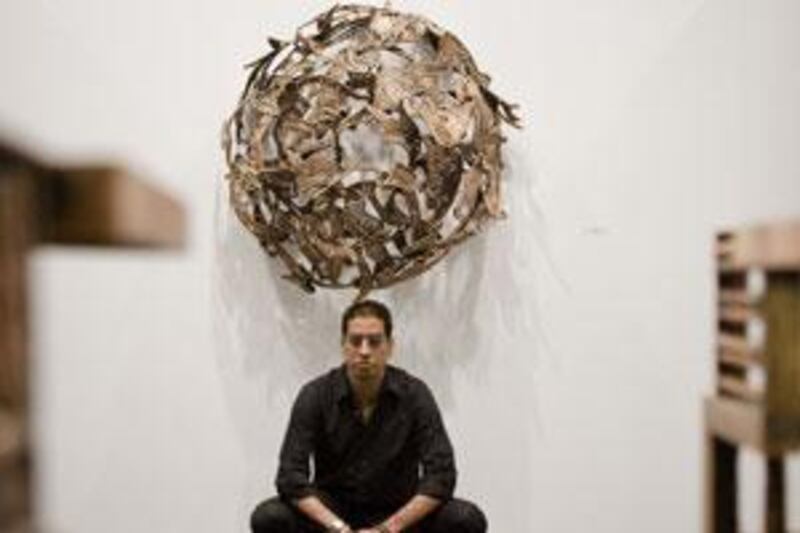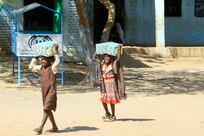Amin Gulgee is breathlessly talking me through his new solo exhibition while constantly tapping his right foot on the floor, as if he has some kind of nervous twitch. The Pakistani artist's second solo collaboration with the Dubai gallery Artspace is entitled Looking For The Magic Centre. Nine large copper sculptures dot the gallery and a selection of his jewellery is displayed in a glass cabinet in the corner.
Gulgee tells me that he fell upon the show's title having read a book called Islamic Patterns by the art professor Keith Critchlow. The book concentrates on the use of geometric patterns in Islamic art, but Gulgee picked up in particular on Critchlow's discussion of the centre of a piece of art - its point of origin. "I never draw my work before beginning," Gulgee says. "So when I begin a piece I really don't know where it's going because I try to keep myself open. The process is all-important, more important than anything that's produced."
So, for Gulgee, the significance of the point of origin is that it marks the very beginning of his unknown journey with each piece he creates. Unlike his father, the renowned Pakistani portraitist Ismail Gulgee, Amin has always focused on sculpture, and more specifically copper sculpture. "It's one of the oldest metals, used since time began," he explains. "But I feel I can achieve new textures and emotions in the material and that's challenging and intriguing for me."
Some would say it's unsurprising that Gulgee has forged a career in the art world, given that his father was such a world-respected artist. Ismail Gulgee devoted most of his artistic life to portraits, the names of those he painted reading like a Who's Who of global leaders: the entire Afghan royal family in the 1950s: Pakistani leaders such as Zulfikar Ali Bhutto and General Ayub Khan, Zhou Enlai, Charles de Gaulle, Richard Nixon, Rajiv Gandhi. The list goes on and on. "He did everybody," says Gulgee. "His life was wonderful."
But it was a life that ended tragically at the end of 2007 after Ismail and his wife, Zareen, and their maid were all found murdered in their house in Karachi. Living next door, Amin discovered their bodies after they had lain there for three days. Understandably, it's a harrowing topic for him and his voice drops when discussing the ongoing criminal case surrounding their deaths. He explains that the Pakistani police now believe they have the two culprits in prison awaiting trial. "I want justice for my parents," he says with emotion. "You know he was a great artist, but he was also a wonderful father and my mother was just incredible. I lost my best friends."
Despite the pressure of his father's success hovering over him for much of his career and the legacy he has left behind, Gulgee is quick to point out that his parents gave him complete freedom to do what he wanted to do. It was a shock to them initially, he admits, when he first announced that he wanted to follow his in his father's creative footsteps because they had other ideas for his career - and that of his sister, Fahmi. "They thought my sister would do fine art because she'd get married and I would have to support a family so I'd need something practical to do.
"My father was famous and established so my parents never wanted me to be an artist. Quite frankly, I never wanted to be one either. I grew up with the artistic lifestyle and I just didn't think I was tough enough for it," he adds. After attending the American School in Karachi, Gulgee initially tried to heed his parents' wishes and resist the creative path by going to Yale to study economics. "I was really in total denial of the arts. Instead I thought I'd study economics and have a quiet, obscure life in America with a nice car. But I hated it, I found it the most boring thing in the world."
By chance, a friend of his then invited him to a history of art class which, he says, is when his transition from finance to art occurred. "I went and I thought: "Oh, isn't this wonderful? this is so much better than looking at supply and demand graphs." So I took one class, then another and another, and before I knew it I had a major in it as well as economics." Just as well that he didn't go into finance because, given the current economic turmoil, he might not have that quiet life or car now. On the other hand, the prices from Gulgee's latest show indicate that he can command sums of up to $40,000 (Dh146,000) and has become a success in his own right.
It wasn't instant, though. He spent several years in New York selling his jewellery pieces from a small gallery on West Broadway, with odd jobs on the side, such as a stint in the Metropolitan Museum's shop, to help pay the bills. Although Gulgee loved fashioning jewellery and still does today, he felt an increasing need to create bigger pieces. So he returned home to Karachi determined to concentrate on developing sculptures. He lived with his parents for a year before landing his first show, having cajoled some of his father's contacts into supporting him. Success grew from there.
Looking at his sculptures in the show, I ask if perhaps his focus on them, rather then following his father into painting, was a conscious move to carve out his own identity. The reply is an emphatic "No". Gulgee's art career has now spanned nearly 20 years, during which time he has built up a reputation for not only his sculpture and jewellery, but for performance art which utilises his copper designs.
He says that he relishes the variation in his work, ranging from detailed earrings to huge installations. His largest project was for a roundabout in Karachi, for which he created a 13.5-metre-high sculpture called Forgotten Text. It was a piece that he tells me took approximately three years to create. However, he is less precise on the timing for his Artspace show. "I work with objects which are sometimes created years before I start using them," Gulgee says of the pieces he uses to fuse his sculptures together. "So there's an incubation period before they start getting assembled where they lie dormant in my storage room."
"A bit like a sculpture graveyard?" I ask. "Exactly," he replies. "My storage rooms are as large as my working spaces and they all contain rolling projects. Like that spider piece," he says of one of the show's abstract sculptures. "The pieces for that were done three years ago." At $30,000 (Dh110,000), Spider II is one of the most expensive pieces in his new exhibition and, at 1.5 metres high, also one of the largest. Gulgee tells me it was partly inspired by the spider structures of the French artist Louise Bourgeois. It is held together by strips of copper in the shape of the insect, along which are abstract patterns created from Islamic calligraphy. The wavelike structure Ocean IV is also moulded from abstract calligraphic shapes. The use of such iconic Islamic art presents an interesting contradiction within his work. The twisting curves and angles of his work have a strong leaning toward Modernism and the combination of these elements balances traditional art within a more contemporary framework. In many ways this aspect of his pieces is reminiscent of his father, who also took frequent inspiration from calligraphic techniques.
The standout pieces of the collection are those inspired by history - specifically the history of Pakistan, a theme that Gulgee says he uses to try "to understand himself, his home and his own spirituality". The show features two separate works in the shape of chapattis, simply because they are so evocative of the country. History too, provides the inspiration for the most striking pieces of the show. Charbagh is a large work in which 47 masks, all replicas of his own face, are crammed together in memory of the 1947 partition between India and Pakistan.
Gulgee brims with energy while discussing them, that foot still jiggling up and down as he speaks. "Touch the sculptures - touch them," he says. "I just remember when I was a kid, I would be carted all over Europe to museums and galleries and my mother would always tell me not to touch things. It was so frustrating." Mentions of Gulgee's parents have peppered our conversation, then he tells of his plans for a collection of his father's work to be opened in Karachi. "It's something that both my sister and I agree on. Nothing was put in writing but the wishes were that a museum will be created." Before then though, he wants the criminal case to have at least started. "But I have no idea when that is going to happen.
"The good thing is that my parents' life together was not the murder," he adds. "They, and my mother in particular, were great believers in the power of goodness. There's an inherent goodness in people that ties us all together. I still believe that. I have to, otherwise one totally gives up and hides on a mountain top."





